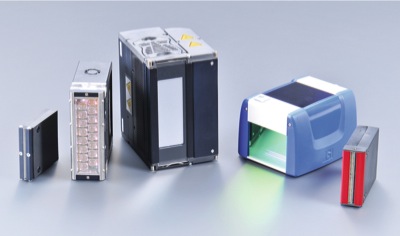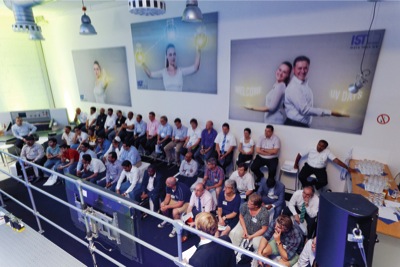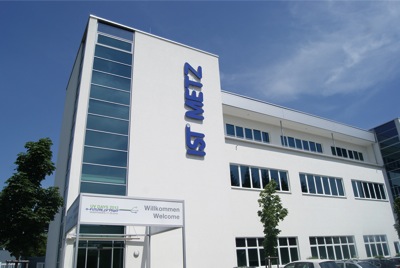The IST Metz UV Days are held every two years at the company headquaters in Nurtingen, in southern Germany.
In the sweltering Swabian summer, IST Metz GmbH opened its doors for the internationally renowned UV Days for the sixth time, to show the capabilities and benefits of UV LED curing. By Michal Lodej.
With the theme the ‘Future of Print’, around 600 visitors were welcomed to IST Metz’s headquarters in Nürtingen, in southern Germany, by managing director, Dirk Jägers, and sales director, Holger Kühn. They told the guests, ‘Print is changing. There is a lot more involved in printing now, such as the new technology of augmented reality. Looking at figures and statistics it appears that most areas of printing are in decline, however, areas where you can still see growth is in the packaging and labels industry.’
Leading the way
One of the topics of the event, which ran from 17 to 20 June, was ink curing using light-emitting diodes (LEDs). ‘Here at IST we always want to make our technology more energy efficient and environmentally friendly and that is exactly what can be achieved with UV LED curing,’ said Mr Jägers.
Live demonstrations showed guests the company’s UV LED applications in action introducing the new LEDZero Solidcure 2 system from its partner, Integration Technology Ltd. These watercooled units were mounted on a standard 430 mm narrow web flexo press running at 150 m/min and the ink was fully cured at a power rating of 0.12 W/m2. This demonstrated the major benefit of LEDs, namely that the power consumption is far less than conventional mercuryfilled UV lamps, saving on energy costs.
‘We have met a basic requirement here that many experts have been demanding as a prerequisite to the introduction of UV LED technology into traditional market segments,’ said Mr Jägers.
‘Having increased the performance of these systems, we are now in a position to achieve printing speeds in line with label printing standards. The move into narrow web flexo printing is thus within reach. We want to be able to help printers by saving them on the costs of printing.’
The UV LED lamps can be switched on and off instantly without any need to warm up or cool down. There is also the option to switch off parts of the lamp whilst keeping some parts on when only certain areas of the substrate need to be cured. Another benefit of the LEDs is that no ozone is produced and only minimal heat output.
 UV LED products from IST Metz
UV LED products from IST Metz
‘The UV LED lamps are a higher initial investment compared to the conventional curing systems, but the cost savings make up for this in the long term. We expect that this form of curing will soon be the main solution used,’ added Simon Mitchell, managing director, IST (UK) Ltd.
UV LED units are frequently being used in single pass process for inkjet printing. In this market, they are used for both the pinning of the ink drops between inkjet heads and as the final curing of the inks. IST printed a sample adhesive label using an inkjet system with 140 mm printing width, equipped with Pincure Plus LED UV units for pinning. These have an extremely slim form factor, a very discreet light output and are scalable in increments of 80 mm to allow for the adjustment of their length (max length 2800 mm) to suit the various application widths.
Bright idea
Showcasing multi-functional packaging, the company presented its vision of the future of print. This came in the form of a piece of threetier packaging comprising an outer box containing a labelled tin and a folded piece of parchment. The product inside was a barbecue salt from Altes Gewürzamt GmbH Ingo Holland.
The label on the tin was printed on PVC transparent film using a Spartanics NW 140 by INX, and due to the innovative design, it appeared as though it was printed directly onto the tin. Once the tin was removed from its outer packaging, the concertinaed paper below folded out upwards, and became a table lantern lit by an LED situated in the packaging base. The paper used for the lantern effect was transparent and printed on a Heidelberg Speedmaster CD 102-7 LX with black ink and finished with a gloss varnish.
During the process the transparency of the paper was not altered, essential for the purpose of this particular use. The live demonstration showed outer packaging being printed on the Speedmaster, fitted with IST’s energy-efficient interdeck and end-of-press dryers.
Busy event
The open house event also included seminars and tours of the IST facilities. The company was founded in 1977 and today employs 500 staff across the group of 15 companies. It has international subsidiaries in France, England, Italy, the USA, the Netherlands, Spain, Sweden, China and Thailand, and a large support network of agencies.
 Visitors were treated to presentations on all aspects of UV curing
Visitors were treated to presentations on all aspects of UV curing
Klaus Ludwig, product manager from PolyIC GmbH & Co KG, and Thomas Strubreiter, pre-sales engineer, Thin Film Electronics ASA, gave a talk on printed electronics. Their presentations emphasised that printed electronics is not the same as printed circuit boards and that it will never replace conventional electronics, but when applied to packaging it can create interactive and smart packaging, giving consumers knowledge about the products they buy, such as whether or not it has ever been kept above a certain temperature, vital information for the food and pharmaceutical market.
As part of the open house, there was a table top exhibition where 26 suppliers showed their goods and services. These included Heidelberg, Zeller+Gmelin, Flint Group, INX International UK Ltd, Gallus, DPLenticular Ltd, Müller Martini, hubergroup and Kocher+Beck.
Thomas Geiger from Gallus said, ‘We have had some interesting customers throughout the open days, it is not a big exhibition, but that is all part of the event’s charm.’ Mr Jägers concluded, ‘We are extremely satisfied with the course of the UV Days. These four days gave us the ideal opportunity to bring our innovative idea of a packaging to potential and existing customers.’






